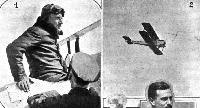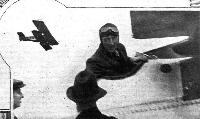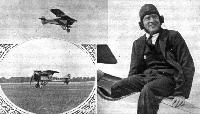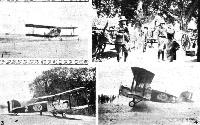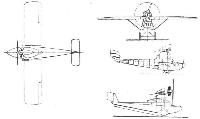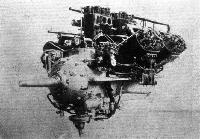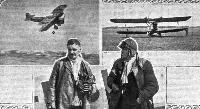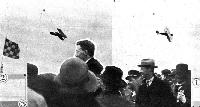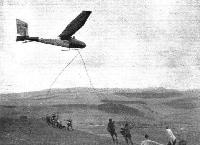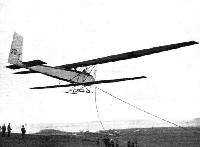Фотографии
-
THE KING'S CUP: Mr. A. J. Cobham being congratulated on having secured second place. Inset, the Napier "Lion"-engined D.H.9 passing over the winning line.
Самолёты на фотографии: De Havilland D.H.9A - Великобритания - 1918
-
SECOND IN THE KING'S CUP RACE: 3, Capt. Norman Macmillan crossing the finishing line on his Fairey III.D (Napier "Lion"). 4, Capt. Macmillan, complete with pipe
Самолёты на фотографии: Fairey Fairey III - Великобритания - 1917
-
Регистрационный номер: G-EBFN FIRST IN THE KING'S CUP RACE: 1. Mr. A. J . Cobham getting out of his D.H.50 (Siddeley "Puma") after winning the race. 2, Cobham, crossing the finishing line.
Самолёты на фотографии: De Havilland D.H.50 - Великобритания - 1923
-
The Armstrong-Whitworth "Siskin," piloted by Flight Lieut. Jones, made the fastest time. Our photo, shows one of the large petrol tanks, and the "Jaguar" engine.
Самолёты на фотографии: Armstrong Whitworth Siskin - Великобритания - 1921
-
Регистрационный номер: G-EBEU [2] THE SECOND KING'S CUP RACE, 1923: F. C. Courtney seated in the Siddeley "Siskin" (Siddeley "Jaguar") after the winning of the King's Cup Race. Inset, the "Siskin" crossing the line.
Самолёты на фотографии: Armstrong Whitworth Siskin - Великобритания - 1921
-
Регистрационный номер: G-EBJQ THE FASTEST MACHINE IN THE KING'S CUP RACE: The two photographs on the left show the Armstrong-Whitworth "Siskin," which was fourth under the handicap, crossing the finishing line, and, below, alighting on the Gosport aerodrome. On the right Flight-Lieut. Jones getting out of his machine.
Самолёты на фотографии: Armstrong Whitworth Siskin - Великобритания - 1921
-
Регистрационный номер: G-EBEU [2] THE RACE FOR THE KING'S CUP: Ten of the faster machines, arranged in the order of starting: 10, Siddeley Siskin, with 350 h.p. Siddeley "Jaguar" engine.
Самолёты на фотографии: Armstrong Whitworth Siskin - Великобритания - 1921
-
Just before the Start: Our picture shows Major Zanni and his engineer, Mr. Beltrame, while between them is Mijnheer Anthony Fokker, the designer of the machine. It is of interest to note that for the world-flight an Argentine pilot flying a Dutch machine should have chosen a British Napier "Lion" engine.
Самолёты на фотографии: Fokker C.IV / DC.I - Нидерланды - 1923
-
THE DORNIER "WAL" AT STROMNESS: This flying boat, built entirely of metal, was designed by Herr Dornier, a German designer, was built in Pisa by Italian workmen, and is fitted with two Rolls-Royce "Eagle" engines, placed in tandem above the wing.
Самолёты на фотографии: Dornier Do.J Wal - Германия - 1922
-
Регистрационный номер: N166 TWO VIEWS OF THE BLACKBURN "CUBAROO" IN FLIGHT: The photograph on the left shows the machine taking off.
Самолёты на фотографии: Blackburn Cubaroo / T.4 - Великобритания - 1924
-
THREE VIEWS OF THE BLACKBURN-NAPIER "CUBAROO" TORPEDO-' PLANE: This machine is fitted with a Napier "Cub" 1,000 h.p. engine, and carries a crew of three. The lower photograph shows a number of people sheltering from the rain underneath the starboard lower plane, and illustrates the claim that this is the world's largest single-engined aeroplane.
Самолёты на фотографии: Blackburn Cubaroo / T.4 - Великобритания - 1924
-
THE BLACKBURN-NAPIER "CUBAROO": These two photographs give a good idea of the wing-folding arrangement, and also the view on the left shows the cowling of the Napier 1,000 h.p. "Cub." The right-hand photograph brings out the high position of the rear gunner's cockpit.
Самолёты на фотографии: Blackburn Cubaroo / T.4 - Великобритания - 1924
-
THE AMERICAN WORLD-FLIGHT: One of the Douglas world-cruisers, the "Chicago," filling up with "Shell" at Karachi, India, in July last.
Самолёты на фотографии: Douglas DWC / World Cruiser - США - 1923
-
THE AMERICAN WORLD-FLYERS IN INDIA: We have received the above "snaps" from Sergt. V. R. Fraser, who is stationed at Multan, one of the stopping-places on the American World-Flight. (1) No. 2 Douglas World Cruiser taxying on the "aerodrome" at Multan, July 3. (2) Unloading petrol and oil for the American machines (note the native method of transport). (3) No. 2 machine, "Chicago," at rest after its arrival. (4) No. 3 machine arriving at Multan, July 3. All three machines departed early next morning for Karachi.
Самолёты на фотографии: Douglas DWC / World Cruiser - США - 1923
-
Регистрационный номер: G-EBDK, G-EBDO [2] THE KING'S CUP: Three interesting machines at Hendon for the start. Left to right, Mr. Alan S. Butler's D.H.37 (275 Rolls-Royce "Falcon 3"), flown by Major H. Hemming; Mr. F. P. Raynham's Martinsyde F.6 (700 Wolseley "Viper"), piloted by himself; Mr. Douglas Vicker's Vickers "Vulcan" (450 Napier "Lion"), flown by Capt. S. Cockerell.
Самолёты на фотографии: De Havilland D.H.37 - Великобритания - 1922Martinsyde F.4A / F.6 / A - Великобритания - 1919Vickers Vulcan / Type 61 - Великобритания - 1922
-
Регистрационный номер: G-EBDO [2] THIRD IN THE KING'S CUP RACE: 5, Mr. A. S. Butler alighting from his D.H.37 (Rolls-Royce "Falcon") after having secured third place in the race. 6, Mr. Butler crossing the finishing line.
Самолёты на фотографии: De Havilland D.H.37 - Великобритания - 1922
-
Dornier Sparrow
Самолёты на фотографии: Dornier Do.A Libelle / Spatz - Германия - 1921
-
Регистрационный номер: F-ESAO Унаследовавший многие особенности конструкции у машин семейства F.60, Farman F.62 был дальним самолетом с хорошо закапотированным двигателем водяного охлаждения и большим запасом топлива. Обратите внимание на радиаторы на передней части стоек кабана.
THE FARMAN F.62: Fitted with a 450 h.p. Farman engine, this machine has established a new World's Record (Duration) of 38 hours. The machine is similar to the "Goliath" except for the single engine.
HOLDER OF THE WORLD'S DURATION RECORD: The Farman F. 62, on which recently, Drouhin and Landry established a new world's record by flying for 45 hours 12 mins. without landing, covering in that time a distance of 4,400 km. (2,740 miles), which is also a record. The engine fitted is a 12-cylinder Farman of the "W" or "Broad Arrow" type.Самолёты на фотографии: Farman F.62 - Франция - 1924
-
The Farman aero engine, type 12 WD, which was fitted in the F.62 that established a new world's record for duration. The engine is of the "Broad Arrow" type, with 12 cylinders in three' banks of four each.
Самолёты на фотографии: Farman F.62 - Франция - 1924
-
Регистрационный номер: N9605 THE THIRD KING'S CUP RACE, 1924: The Supermarine "Seagull" Amphibian flying boat, 450 h.p. Napier "Lion," two of which are entered in this year's race.
Самолёты на фотографии: Supermarine Seal / Seagull - Великобритания - 1921
-
Регистрационный номер: G-EBIP THE VICKERS "VIXEN": On the left Sqdn.-Ldr. Payn crossing the finishing line, fifth under the handicap, and, on the right, the "Vixen" taxying in. Below: Sqdn.-Ldr. Payn and his passenger, Mr. J. Wyatt.
Самолёты на фотографии: Vickers Vixen / Venture / Valparaiso / Valiant - Великобритания - 1923
-
The Vickers "Valparaiso" military two-seater, with Napier "Lion" engine.
Самолёты на фотографии: Vickers Vixen / Venture / Valparaiso / Valiant - Великобритания - 1923
-
Регистрационный номер: G-EAMU FINISH OF THE RACE FOR THE KING'S CUP: 1, Barnard crossing the finishing line. 2, Raynham finishes two minutes later. 3, Chairing the winner. Towards the right-hand side of the picture Raynham may be seen smiling good-humouredly at the hoisting of his successful rival.
Самолёты на фотографии: De Havilland D.H.4A - Великобритания - 1919Martinsyde F.4A / F.6 / A - Великобритания - 1919
-
From the Rhon Meeting: No. 46 ("Moritz") and No. 35 ("Margarete") in the air together. On this occasion "Margarete" is not carrying a passenger.
Самолёты на фотографии: Darmstadt D-04 - D-07 - Германия - 1922Hannover H.1 Vampyr / H.2 Greif / Strolch - Германия - 1921
-
Two-seater Gliders: Front portion of the "Margarete" (No. 35), showing two cockpits and peculiar mounting of the monoplane wing.
Самолёты на фотографии: Darmstadt D-04 - D-07 - Германия - 1922
-
From the Rhon Meeting: The Espenlaub V gets away.
Самолёты на фотографии: Espenlaub E.03 - E.05 - Германия - 1922
-
From the Rhon Meeting: Launching No. 70, the Ksoll biplane glider "Breslau." Note that a passenger is carried.
Самолёты на фотографии: Ksoll Breslau - Германия - 1924
Статьи
- Flight


